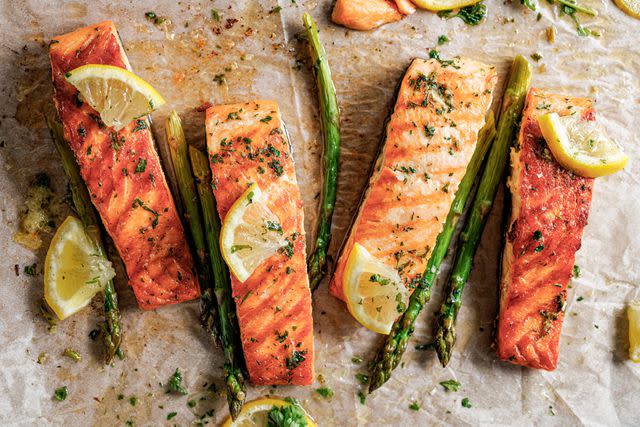How to Defrost Fish the Right Way, According to a Seafood Expert
Also, why you may prefer cooking fish from frozen rather than defrosting it.

If seafood is a regular part of your weekly menu, you've likely bought your fair share of frozen fish. The freezer staple makes it easy to add lean protein to any meal, whether you're slow baking salmon or poaching halibut in oil. But in order to enjoy all that frozen fish has to offer, it's important to learn how to thaw it properly.
Related: How to Get Crispy Skin When You Cook Fish Fillets
Why You Should Choose Frozen Fish Over Fresh
Contrary to popular belief, fresh fish isn't necessarily "fresher" than frozen fish. In fact, for optimal flavor and quality, experts recommend frozen fish over fresh. The reason? According to SeaChoice, most fish is flash frozen right after it's caught. Not only does this help retain nutrients, but it destroys harmful bacteria too. In contrast, fresh fish can take at least a week to travel from the sea to your supermarket's refrigerator, during which time the fish's quality can drastically deteriorate.
In Alaska, wild seafood is harvested at the peak of freshness and frozen within hours, says John Burrows, seafood technical director at the Alaska Seafood Marketing Institute in Juneau. "This quick turnaround ensures the fish has the same quality as it would have if eaten on the dock with the fisherman at landing," he says. The process of freezing fish also ensures strict temperature control, the most important factor for maintaining the quality of fish.
What's more, freezing seafood and fish increases the availability of these delicious items. As Burrows notes, all wild seafood in Alaska—such as salmon, pollock, and cod—is harvested seasonally. But when these foods are frozen, it makes it possible for consumers to enjoy them all year while maintaining integrity and flavor.

How to Defrost Frozen Fish
The best way to defrost frozen fish is in the refrigerator overnight. According to Burrows, this slow thawing method will allow you to control the temperature (which, again, is key for quality).
Place a wire rack or drip pan on top of a sheet pan. Remove the fish from the packaging it was purchased in, and place the fish on top of the rack.
Lightly cover the fish with a single layer of plastic wrap, ensuring there's enough material to be folded around the ends of the pan to seal it.
Place the pan in the refrigerator to thaw. This will take between 10 and 36 hours depending on the size and thickness of the piece(s) of fish.
Quick Thaw
If you're short on time, you can quick-thaw the fish in cold water. Burrows outlines the technique:
Remove the fish from the packaging it was purchased in and place in a resealable plastic bag.
Submerge the bagged fish in a bowl of cold water, replacing the water as needed until the fish is thawed, about 10 minutes.
Storing Thawed Fish
Once the fish has defrosted, it's best to prepare it immediately. But if you're unable to cook it straight away, you can store thawed fish in the fridge in a plastic bag or airtight container, which will maintain its temperature and integrity, says Burrows. Use the fish within a few days and avoid refreezing it, as this could damage quality.
Safety Tips for Thawing Frozen Fish
Although the flash freezing process kills harmful microorganisms, it's still worth taking safety precautions when defrosting frozen fish. When preparing the vessel for your fish, keep it separated from other foods, especially those that are cooked or ready to eat. Wash your hands, equipment, and utensils before and after handling the fish, and before cooking your meal. Additionally, discard the plastic wrap or bags used to defrost the fish.
As your fish thaws, check its quality via smell, touch, and sight. It should not smell "fishy," but instead like a clean ocean breeze, says Burrows. The flesh should also be firm, moist, and flavorful. Keep an eye out for any physical or odor changes as it thaws.
How to Cook Fish From Frozen
Should you want to skip the thawing process, it's also possible to cook fish straight from the freezer. "In fact, cooking from frozen is [often] easier than cooking from fresh because it's harder to overcook this way," shares Burrows. "This makes cooking from frozen a great way for new or inexperienced home cooks to get comfortable with cooking seafood."
Coat both sides of a frozen fish filet with oil, then place it, uncovered, in a heavy nonstick skillet or stovetop grill pan, over medium-high heat.
Cook for approximately three minutes, then flip, season, and cover.
Turn the heat down to medium and cook for another six to eight minutes, or until the flesh is opaque.
Using this technique, "you could have a delicious and nutritious dinner on the table in [less than] 15 minutes," says Burrows.

